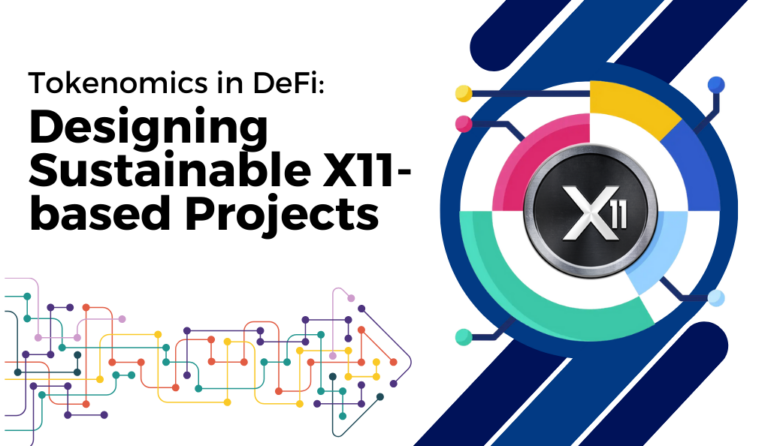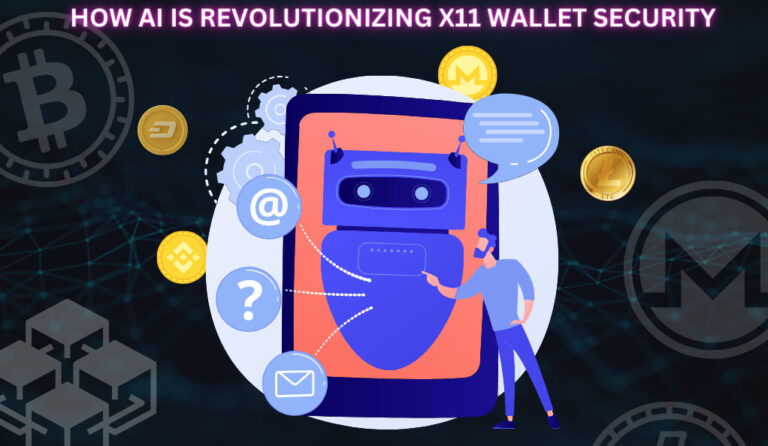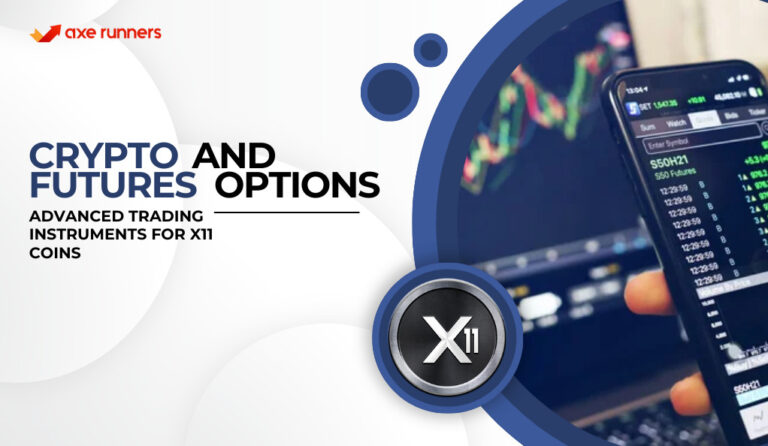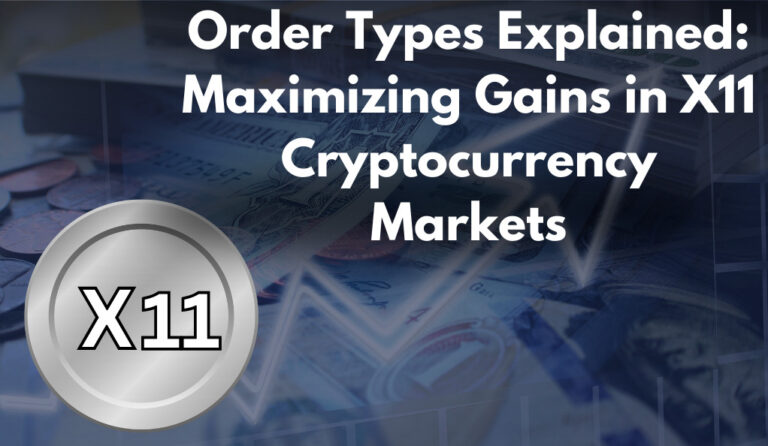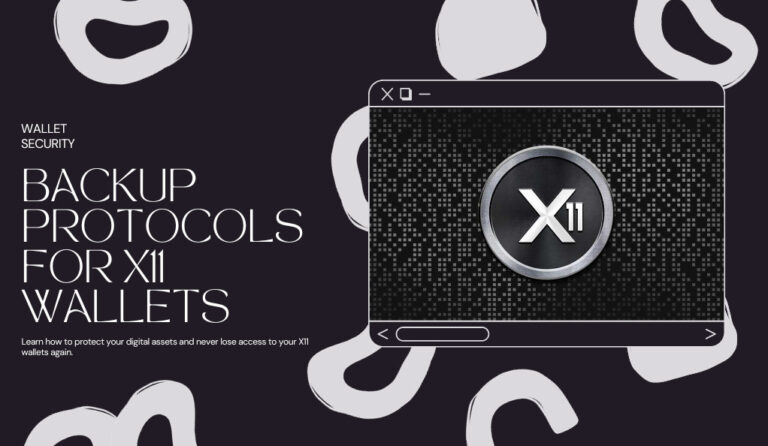Decentralized Finance (DeFi) refers to the use of blockchain technologies and cryptocurrencies to recreate and improve upon traditional financial systems and services. Unlike traditional finance, where banks and financial institutions act as intermediaries, DeFi operates on decentralized networks, allowing individuals to interact directly with one another.
Key Components of DeFi
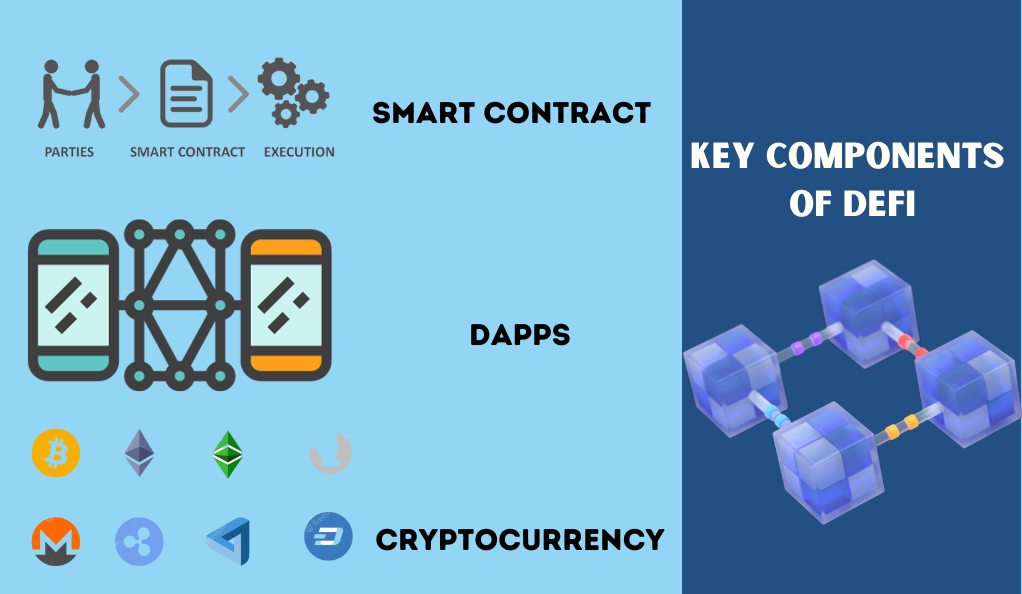
- Smart Contracts: These are self-executing contracts with the terms written into code. They automatically execute actions such as transfers, loans, and trades without the need for intermediaries.
- Blockchain: A decentralized ledger that records all transactions across a network of computers. This ensures transparency and immutability.
- Cryptocurrencies: Digital or virtual currencies like Bitcoin and Ethereum that are used within the DeFi ecosystem.
- DApps (Decentralized Applications): Applications that run on a decentralized network, providing various financial services like lending, borrowing, and trading.
| Feature | Traditional Finance | Decentralized Finance (DeFi) |
|---|---|---|
| Intermediaries | Banks, Brokers | None |
| Accessibility | Restricted | Open to Anyone |
| Transparency | Limited | Full Transparency |
| Control | Centralized Authorities | Users |
| Fees | Often High | Lower or None |
| Innovation | Slower | Rapid Development |
Advantages of DeFi
- Accessibility: DeFi is open to anyone with an internet connection, regardless of geographic location or financial status.
- Transparency: All transactions are recorded on the blockchain, ensuring full transparency and auditability.
- Cost Efficiency: By eliminating intermediaries, DeFi often reduces costs associated with financial transactions.
- Innovation: The open-source nature of DeFi encourages rapid innovation and development of new financial products and services.
Challenges and Risks
The realm of decentralized finance (DeFi) presents a series of challenges that need careful consideration. Security risks stand as a prime concern, particularly when it comes to smart contracts. If these contracts are not meticulously coded, they can become susceptible to hacking attempts, potentially compromising the entire system’s integrity.
Adding to the complexity is the regulatory uncertainty surrounding DeFi. As this innovative financial landscape continues to evolve, its legal status remains in flux. This ambiguity opens the door to potential regulatory challenges that could impact the way DeFi operates and is integrated into the broader financial ecosystem.
Moreover, while DeFi offers remarkable opportunities, its usability can pose difficulties, especially for newcomers. Navigating the intricacies of the current DeFi landscape demands a certain level of understanding and expertise. This means that beginners might face a steep learning curve, requiring access to education and guidance to make informed decisions and avoid unnecessary pitfalls.
How DeFi Works: The Basics
Decentralized Finance, commonly known as DeFi, is revolutionizing the way we think about and interact with financial systems. But how does it work? Let’s dive deep into the basics of DeFi to understand its core mechanisms and functionalities.
Blockchain: The Foundation of DeFi
At the heart of DeFi is the concept of a blockchain. A blockchain is a decentralized and distributed ledger that records transactions across multiple computers in a way that ensures the data can only be modified by consensus.
- Immutable: Once data is recorded on the blockchain, it cannot be altered.
- Transparent: All transactions are visible to anyone and can be audited.
- Decentralized: No single entity has control over the entire blockchain.
Smart Contracts: The Building Blocks
Smart contracts are self-executing contracts where the terms of agreement or conditions are written into lines of code. They are the primary tool that enables the functionalities of DeFi platforms. These contracts have several key characteristics. They are Automated, meaning that actions are executed automatically when conditions are met. They are Trustless, signifying that transactions occur without the need for intermediaries or trust between parties. Additionally, they are Interoperable, which allows smart contracts to interact with other contracts, creating complex functionalities.
Tokens: The Lifeblood of DeFi
In the DeFi ecosystem, tokens represent various assets and are often used to facilitate transactions or represent ownership.
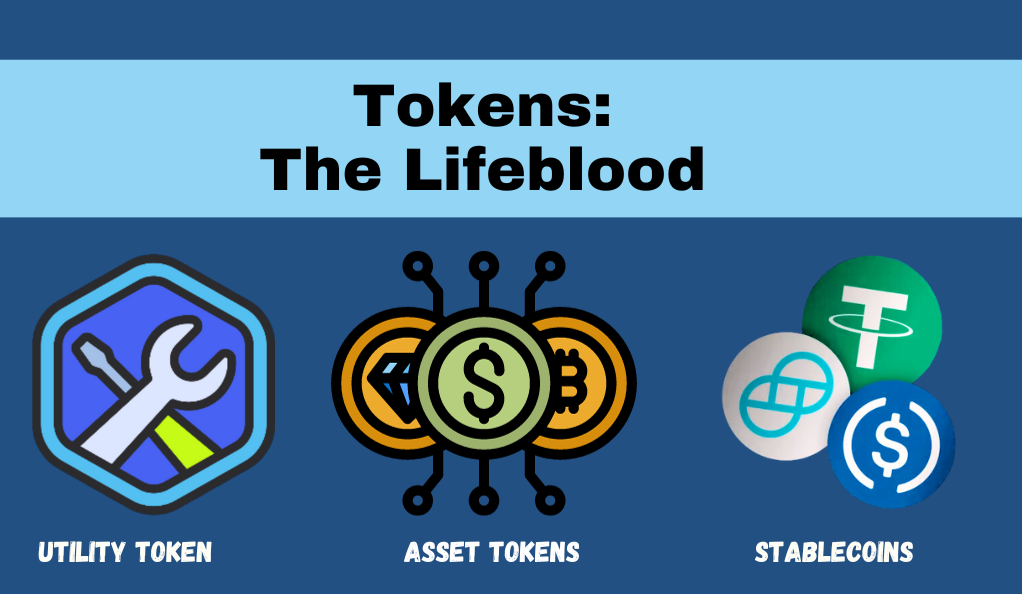
- Utility Tokens: Provide access to a project’s features.
- Asset Tokens: Represent ownership in an asset, like real estate or stocks.
- Stablecoins: Pegged to stable assets like the US dollar, providing price stability.
| Type of Token | Use Case | Example |
|---|---|---|
| Utility | Access to a platform’s service | BAT (Brave) |
| Asset | Represent digital ownership | CryptoKitties |
| Stablecoin | Pegged to traditional currency value | USDC, DAI |
Protocols and DApps: The DeFi Landscape
DeFi platforms are often built on top of protocols which set standard rules for various financial operations. On top of these protocols, DApps (Decentralized Applications) are built to provide user-friendly interfaces. Among these functionalities, Lending Protocols allow users to lend or borrow assets. Additionally, Decentralized Exchanges (DEXs) facilitate peer-to-peer trading of assets, and Yield Farming Platforms enable users to earn returns on their assets. Together, these features contribute to a robust and multifaceted decentralized finance ecosystem.
Decentralized Governance: Power to the People
Many DeFi platforms use governance tokens to allow users to vote on changes to the platform. This ensures that the platform evolves according to the needs and desires of its users.

- Proposal: Users suggest changes or new features.
- Voting: Token holders vote on proposals.
- Implementation: If a proposal is approved, it’s implemented into the platform.
Interoperability: The Composability of DeFi
One of the most powerful features of DeFi is its composability. Different DeFi platforms can easily interact and build upon each other’s functionalities.
- Money Legos: DeFi platforms can be stacked and combined like building blocks.
- Integrated Services: A user can lend assets on one platform and use them as collateral on another.
Security and Risks in DeFi
While DeFi offers numerous advantages, it’s essential to be aware of potential risks. One such risk is Smart Contract Vulnerabilities, where if a smart contract has a bug, it could be exploited, leading to financial loss. Liquidity Risks also pose a challenge, as some platforms may not have enough liquidity, affecting users’ ability to withdraw or trade assets. Additionally, Regulatory Uncertainties present an ever-changing challenge, as the legal landscape for DeFi is still evolving. Understanding these potential risks is vital for anyone engaging with DeFi platforms and services.
Getting Started with DeFi
Embarking on your journey into the world of Decentralized Finance (DeFi) can be both exciting and empowering. This comprehensive guide will take you step by step through the process of getting started with DeFi, from setting up your wallet to accessing DeFi applications and making your first transactions.
Choose a Secure Wallet
Before you dive into DeFi, you need a secure wallet to store your cryptocurrencies and interact with DeFi applications. Consider using a non-custodial wallet like MetaMask or Trust Wallet.
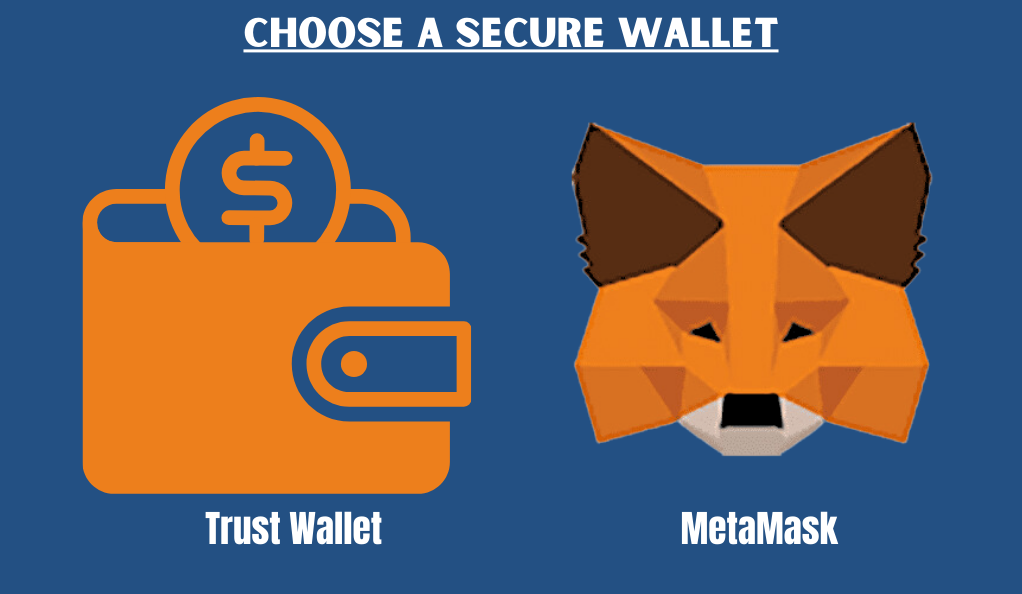
- MetaMask: A browser extension wallet that provides easy access to DeFi platforms.
- Trust Wallet: A mobile wallet that supports a wide range of cryptocurrencies.
Acquire Ethereum (ETH)
Most DeFi transactions occur on the Ethereum blockchain, so you’ll need to acquire Ethereum (ETH) to get started. You can purchase ETH from popular exchanges like Coinbase, Binance, or Kraken.
Connect Your Wallet to DeFi Applications
Once you possess ETH in your wallet, you gain the ability to link it with a range of DeFi applications, thereby initiating your engagement with the decentralized ecosystem. To initiate this connection, open your wallet extension or app, and upon being prompted by the DeFi application, click on the “Connect” option. By establishing this connection, you grant the application permission to interact with your wallet, facilitating transactions and approvals seamlessly.
Explore DeFi Platforms
DeFi offers a wide range of platforms that provide various financial services. Here are some popular DeFi platforms to explore:
- Uniswap: A decentralized exchange (DEX) for trading tokens directly from your wallet.
- Compound: A lending and borrowing platform where you can earn interest on your assets.
- Aave: A lending protocol that offers higher yield opportunities.
Lend, Borrow, and Trade
Lending and Borrowing
- On platforms like Compound and Aave, you can lend your assets to earn interest or borrow assets by providing collateral.
- Explore available assets, interest rates, and collateral requirements before participating.
Trading on DEXs
- Uniswap allows you to trade tokens directly from your wallet without intermediaries.
- Connect your wallet, choose the tokens you want to trade, and execute the swap.
Staking and Yield Farming
Staking
- Some DeFi platforms allow you to stake your tokens to support the network and earn rewards.
- Research platforms like Yearn Finance and Synthetix that offer staking opportunities.
Yield Farming
- Yield farming involves providing liquidity to DeFi protocols in exchange for rewards.
- Understand the risks and potential rewards before participating in yield farming.
DeFi Protocols and Blue Chips
In the dynamic landscape of Decentralized Finance (DeFi), protocols play a pivotal role in shaping the functionalities and services available to users. This comprehensive exploration of DeFi protocols and “blue chip” projects delves deep into the key players that drive the innovation and growth within the DeFi ecosystem.
DeFi Protocols: Building Blocks of Innovation
DeFi protocols are open-source codes that define the rules and functionalities of various financial services on the blockchain. They serve as the building blocks upon which developers create decentralized applications (DApps) that offer services such as lending, borrowing, and trading.
- Aave: A leading lending protocol that allows users to lend and borrow a wide range of assets.
- Compound: Known for its algorithmic interest rates, Compound offers a platform for users to lend and borrow assets with variable interest rates.
- MakerDAO: Famous for its stablecoin, DAI, MakerDAO enables users to generate DAI by locking up collateral in the form of ETH.
Key Features of DeFi Protocols
| Protocol | Lending/Borrowing | Decentralized Exchange | Stablecoin |
|---|---|---|---|
| Aave | ✓ | ||
| Compound | ✓ | ||
| MakerDAO | ✓ |
- Lending/Borrowing: Aave and Compound allow users to lend their assets for interest or borrow against their holdings.
- Decentralized Exchange (DEX): While not exclusive DEXs, protocols like Uniswap also contribute to decentralized exchange functionalities.
- Stablecoin: MakerDAO’s DAI is a decentralized stablecoin that maintains its value through over-collateralization.
Blue Chip Projects: The Cornerstones of DeFi
In the realm of DeFi, “blue chip” projects hold a prominent position, representing established and reputable platforms that wield substantial market influence and boast a considerable user following. These projects not only set industry benchmarks but also demonstrate a consistent history of pioneering advancements, prioritizing security, and gaining widespread adoption.
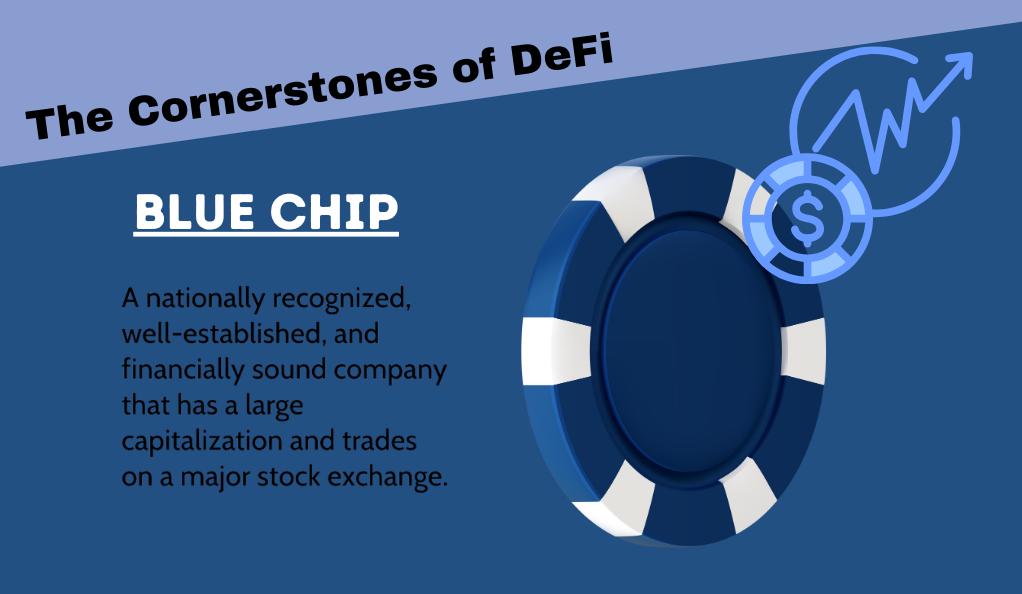
One such example is Uniswap, the foremost decentralized exchange (DEX) renowned for its automated market-making (AMM) mechanisms. Another notable project is Yearn Finance, a decentralized yield aggregator specializing in the optimization of yield farming strategies. Additionally, there’s Synthetix, a platform dedicated to synthetic assets, enabling users to generate and trade synthetic assets linked to real-world equivalents. Each of these projects contributes to the dynamic landscape of DeFi by fostering innovation and reshaping traditional financial paradigms.
| Feature | Aave | Compound | MakerDAO | Uniswap | Yearn Finance | Synthetix |
|---|---|---|---|---|---|---|
| Lending/Borrowing | ✓ | ✓ | ||||
| Yield Farming | ✓ | ✓ | ||||
| Decentralized Exchange | ✓ | |||||
| Synthetic Assets | ✓ |
Choosing and Evaluating DeFi Projects
When choosing DeFi projects to engage with, consider these factors:
- Security: Assess the protocol’s security measures and history of vulnerabilities.
- Audits: Look for projects that have undergone independent security audits.
- Community: A strong and engaged community can indicate a project’s credibility.
- Liquidity: Platforms with high liquidity provide smoother trading experiences.
- Innovation: Consider the uniqueness and utility of the protocol’s features.
Layer 2 Solutions in DeFi: Scaling the Future
As the popularity of Decentralized Finance (DeFi) continues to surge, the Ethereum network has faced scalability challenges. Layer 2 solutions have emerged as a promising solution to address these challenges and enhance the efficiency of DeFi applications. In this exploration, we’ll dive deep into the concept of Layer 2 solutions, their benefits, and their impact on the DeFi ecosystem.
Understanding Layer 2 Solutions
Layer 2 solutions are secondary protocols or frameworks that are built on top of existing blockchains like Ethereum. They aim to improve scalability and reduce transaction costs by processing transactions off-chain while maintaining the security and decentralization of the main blockchain.
Key Layer 2 Approaches
State Channels
State channels enable users to conduct multiple off-chain transactions without interacting directly with the blockchain. The final state is then settled on-chain.
Rollups
Rollups bundle multiple transactions off-chain and submit a single transaction to the main chain. They come in two types: Optimistic Rollups and ZK-Rollups.
- Optimistic Rollups: Transactions are verified off-chain, and if a dispute arises, they are validated on-chain.
- ZK-Rollups: Zero-knowledge proofs are used to aggregate transactions off-chain, ensuring high scalability and privacy.
Benefits of Layer 2 Solutions
| Benefit | Description |
|---|---|
| Scalability | Layer 2 solutions significantly increase transaction throughput and reduce congestion. |
| Lower Transaction Costs | Off-chain transactions minimize gas fees, making DeFi accessible to more users. |
| Fast Transactions | Near-instant transaction finality improves user experience. |
| Environmental Impact | Reduced energy consumption and carbon footprint compared to Layer 1. |
| User Privacy | ZK-Rollups provide enhanced privacy by aggregating transactions. |
Impact on DeFi Applications
Layer 2 solutions have a transformative impact on various DeFi applications:
- Decentralized Exchanges (DEXs)
Layer 2 DEXs offer faster trades and significantly reduced gas fees, making trading more accessible.
- Lending and Borrowing Platforms
Users can engage in lending and borrowing with lower costs and faster transaction finality.
- Non-Fungible Tokens (NFTs)
Layer 2 solutions can enable seamless minting, buying, and selling of NFTs without exorbitant fees.
- Yield Farming and Staking
Layer 2 enhances yield farming and staking by reducing costs and transaction delays.
Choosing the Right Layer 2 Solution
When considering a Layer 2 solution, factors to evaluate include:
- Security: Assess the security mechanisms and reputation of the Layer 2 protocol.
- Adoption: Consider the number of projects and users already using the solution.
- Interoperability: Look for solutions that seamlessly integrate with various DeFi applications.
Investing and Trading in DeFi: Strategies and Opportunities
Decentralized Finance (DeFi) offers a wide array of investment and trading opportunities that empower individuals to participate in the evolving financial landscape. This comprehensive guide delves deep into the strategies, risks, and potential rewards of investing and trading within the DeFi ecosystem.
Investment Strategies in DeFi
Liquidity Providing (LP) and Yield Farming
- Liquidity Providing: By providing assets to liquidity pools, you earn trading fees and potential rewards.
- Yield Farming: Farmers move assets between different protocols to maximize returns.
Staking
- Staking: Locking up assets to support the network’s security and earn rewards.
Investing in DeFi Tokens
- Blue Chip Tokens: Invest in well-established tokens like UNI, AAVE, and COMP.
- Governance Tokens: Hold tokens that provide voting power in the protocol’s decision-making.
Trading Strategies in DeFi
Arbitrage
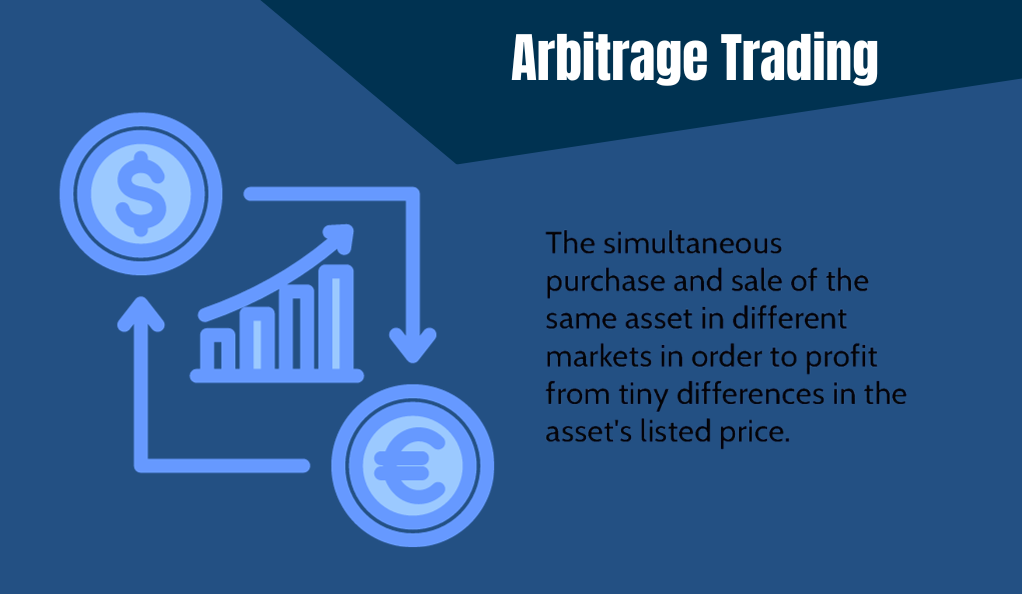
- Arbitrage: Capitalize on price discrepancies between different platforms to make a profit.
Swing Trading
- Swing Trading: Capitalize on short- to medium-term price movements by buying low and selling high.
Day Trading
- Day Trading: Execute multiple trades within a single day to profit from short-term price fluctuations.
Risk Management and Due Diligence
Navigating the landscape of cryptocurrency involves being mindful of several key considerations. First and foremost is the issue of Smart Contract Risk. It’s crucial to verify that the smart contracts you engage with have undergone comprehensive audits and are widely regarded as secure. Another factor to bear in mind is Impermanent Loss, a phenomenon inherent to liquidity provision, wherein fluctuations in asset value can lead to divergent outcomes compared to holding those assets. Additionally, given the notorious Market Volatility of the crypto sphere, it’s wise to brace yourself for abrupt and substantial price fluctuations that are characteristic of this domain. By acknowledging and addressing these factors, you can make more informed decisions within the dynamic realm of cryptocurrencies.
Research and Resources
Project Analysis
Research DeFi projects thoroughly, including their whitepapers, team, use case, and technology.
News and Community
Stay updated on DeFi news and engage with the community to learn about emerging trends.
Educational Content
Leverage tutorials, webinars, and guides to enhance your understanding of DeFi concepts.
DeFi Security and Best Practices: Safeguarding Your Assets
As the popularity of Decentralized Finance (DeFi) continues to grow, ensuring the security of your assets and transactions within the ecosystem is of paramount importance. This comprehensive guide delves deep into DeFi security challenges, vulnerabilities, and best practices to help you navigate the DeFi landscape safely.
Understanding DeFi Security Challenges
DeFi platforms operate in a decentralized and permissionless environment, which introduces unique security challenges:
- Smart Contract Vulnerabilities: Flaws in smart contract code can lead to exploits and loss of funds.
- Centralization Risks: Despite the decentralized nature, certain DeFi platforms have centralized components that could be vulnerable.
- Phishing Attacks: Malicious actors may attempt to trick users into revealing private keys or sensitive information.
- Impermanent Loss: Liquidity providers can face losses due to price volatility.
DeFi Security Best Practices
Choose Reputable Platforms
- Select well-established DeFi platforms with a history of security audits and a strong community.
- Avoid platforms with anonymous teams or inadequate transparency.
Secure Your Private Keys
- Use hardware wallets or non-custodial wallets to store your private keys offline.
- Never share your private keys or recovery phrases with anyone.
Verify Smart Contracts
- Before interacting with a DeFi protocol, review the smart contract code.
- Look for audits conducted by reputable security firms.
Use Strong Authentication
- Enable two-factor authentication (2FA) wherever possible to add an extra layer of security.
Beware of Phishing
- Double-check URLs and ensure you’re on the correct website before entering any sensitive information.
- Be cautious of unsolicited messages or emails asking for your private information.
Protecting Against Impermanent Loss
Understand Impermanent Loss
- Research and understand impermanent loss before providing liquidity to pools.
- Consider long-term liquidity provision to mitigate the effects of impermanent loss.
Diversify Your Portfolio
- Spread your investments across different DeFi projects to reduce the impact of losses in one protocol.
Security Innovations in DeFi
Insurance Protocols, epitomized by platforms like Nexus Mutual, extend a protective shield against smart contract vulnerabilities and potential exploits, bolstering users’ confidence in their financial engagements.
Decentralized Oracles, another pivotal advancement, furnish DeFi platforms with precise price data, effectively mitigating the susceptibility to manipulation, a critical stride towards fostering trust and reliability within the ecosystem.
Staying Informed and Educated
Stay informed about DeFi security best practices by actively engaging with community forums, staying attuned to blogs, and leveraging educational resources. Simultaneously, cultivate a habit of ongoing learning, keeping yourself abreast of emerging security innovations and potential risks to navigate the evolving DeFi landscape with vigilance.
Useful Tools and Resources for DeFi Users
In the dynamic world of Decentralized Finance (DeFi), staying well-informed and equipped with the right tools is essential for navigating the ever-evolving landscape. This comprehensive guide introduces a range of invaluable tools, platforms, and resources tailored to empower DeFi users with the insights and utilities they need to make informed decisions and engage safely.
Wallets and Security
| Wallet | Features | Security |
|---|---|---|
| MetaMask | Browser Extension, Multi-Chain Support | Private Key Encryption |
| Ledger | Hardware Wallet, Secure Offline Storage | PIN Protection, Two-Factor Authentication |
| Trust Wallet | Mobile Wallet, DApp Integration | Biometric Lock, Backup Phrase |
Price Tracking and Analysis
For users keen on monitoring the performance of their assets and identifying potential investment opportunities, price tracking and analysis tools are indispensable. Platforms like CoinGecko and CoinMarketCap offer real-time price data, historical charts, market capitalization rankings, and insights into trading volume for a wide range of cryptocurrencies. These resources empower users to make informed decisions based on accurate and up-to-date information.
Liquidity and Yield Farming
Yield farming and liquidity provision have become central to the DeFi ecosystem. Tools like DeBank and Zapper allow users to monitor their liquidity positions across various protocols, estimate potential yields, and manage their farming strategies efficiently. In addition, platforms like Yearn Finance automate yield optimization by reallocating assets across different liquidity pools to maximize returns.
Auditing and Security Analysis
Given the importance of security in DeFi, auditing tools and services play a pivotal role. Platforms like CertiK and OpenZeppelin offer comprehensive smart contract audits, helping users identify potential vulnerabilities and ensuring that the protocols they interact with are secure. These tools enhance the overall safety of the DeFi experience.
Education and Communities
The DeFi landscape can be intricate, so staying informed is crucial. Educational platforms like DeFi Pulse and CoinDesk offer in-depth articles, guides, and tutorials covering various aspects of DeFi. Engaging with communities on platforms like Reddit and Discord provides users the opportunity to share insights, ask questions, and learn from peers.
Conclusion
The journey into the world of Decentralized Finance (DeFi) has been paved with innovation, opportunity, and transformative potential. As you conclude your exploration, let’s recap the key steps and considerations, culminating in your seamless integration into the DeFi revolution.
At axerunners.com, our goal is to furnish well-rounded and trustworthy information regarding cryptocurrency, finance, trading, and stocks. Nonetheless, we avoid providing financial advice and instead encourage users to conduct their own research and meticulous verification.
Read More

